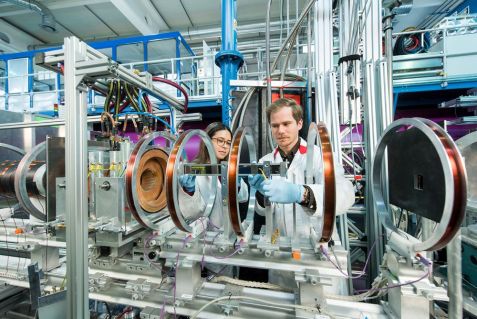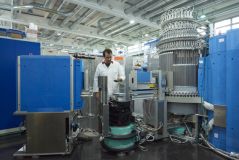MLZ is a cooperation between:
 > Technische Universität München
> Technische Universität München > Helmholtz-Zentrum Hereon
> Helmholtz-Zentrum Hereon
 > Forschungszentrum Jülich
> Forschungszentrum Jülich
MLZ is a member of:
 > LENS
> LENS > ERF-AISBL
> ERF-AISBL
MLZ on social media:

MLZ (eng)
Lichtenbergstr.1
85748 Garching
05.08.2019
Measure faster, higher and hotter: 13 million euros for research with neutrons and positrons
The Federal Ministry of Education and Research (BMBF) is funding 16 projects at the Heinz Maier-Leibnitz Zentrum (MLZ) with around 13 million euros. The funding is awarded for joint research projects that will construct and expand measuring instruments for neutron and positron research over a period of three years.
Higher resolution for the investigation of fuel cells
The projects were submitted by the Technical University of Munich (TUM) and ten other German universities. For example, Dr. Michael Schulz (TUM) at “NeutroSense” will develop a high-resolution detector, together with the University of Freiburg, that can investigate water transport in fuel cells (€1.7 million). “With the new detector, we will be able to measure in the micrometer range. This is ten times better than at present,” explains the TUM scientist. The high resolution is necessary because the membranes in the fuel cells are only a few micrometers thick. Schulz uses the funds to finance two jobs, a Postdoc and a software specialist, as well as the material costs for the detector.
Upgrade for measuring instruments
Other instruments are also expanding their measurement capabilities, such as the Jülich three axes spectrometer PANDA, for which TU Dresden is developing a new multi-detector system called BAMBUS (€0.7 million). The Prompt Gamma Activation Analysis will receive a time-resolved isotope analysis (€ 0.6 million) for the neutron depth profile analysis option from TUM Professor Dr. Bastian Märkisch. Dr. Christian Franz (TUM) extends the measuring range of the so-called MIEZE option (Modulation of IntEnsity by Zero Effort) on the RESEDA resonance spin echo spectrometer in such a way that it also measures samples at small angles (€0.9 million). Prof. Dr. Peter Böni (TUM) is also expanding the MIEZE option on the MIRA three axes spectrometer to investigate the smallest samples with higher time and spatial resolution (€0.5 million). A combined in-situ infrared spectrometer for neutron small-angle scattering systems is being designed by RWTH Aachen together with Dr. Tobias Schrader from Forschungszentrum Jülich. It will investigate the time-resolved folding of proteins or the formation of fibrils that play a role in Alzheimer’s disease (€0.8 million).
Heating, drawing, pressing alloys
Dr. Ralph Gilles (TUM) and the University of Erlangen-Nürnberg are developing a testing machine that can test new superalloys for gas turbines under heat and tension or pressure and investigate crack formation (€0.8 million). Dr. Robert Georgii (TUM) and a colleague from the neutron source ISIS in the United Kingdom are working with a PhD student to develop a concept for a novel crystal time-of-flight spectrometer (€0.2 million) that can measure the structures and movements of matter on an atomic scale with time and spatial resolution.

In future, the robot will be able to perform 80 percent of all measuring tasks on the STRESS-SPEC instrument. © HZG
Robot performs measuring tasks
In another project, the existing robot on the STRESS-SPEC neutron diffractometer will be upgraded so that it can position the samples even more precisely. “This is important when we are investigating additively manufactured components,” says the project manager, Dr. Michael Hofmann. “We want to reduce the deviation of the robot during positioning from currently half a millimetre to 50 micrometres, an improvement factor of 10. With the funding (1.1 million euros), the TUM scientist will hire a Postdoc and an engineer to modify the robot accordingly, including the furnace and neutron optics. The project partner from the University of Erlangen-Nürnberg is responsible for the adaptation of the robot’s control system and is also financing a scientist. “The robot will then be able to perform 80 percent of all measurement tasks for us,” says Hofmann.
New meters for better batteries and faster conductors
The BMBF is also funding instruments that are being built from scratch: the SAPHIR high-pressure press from TUM and the University of Bayreuth (€ 0.5 million), the ERWIN diffractometer for studying batteries from the Karlsruhe Institute of Technology (€ 0.3 million) and the POWTEX high-intensity flight time diffractometer from Forschungszentrum Jülich and RWTH Aachen (€ 1.2 million). The cold three axes spectrometer KOMPASS at TUM and the University of Cologne, which started its test mode in 2018, will be further expanded with research funding, for example to measure superconducting materials.
Working under high pressure
Several measuring instruments at the MLZ benefit from the development of a new horizontal 12 Tesla magnet by Dr. Sebastian Mühlbauer with which liquid samples can be analyzed (€ 0.2 million). The RWTH Aachen project for a new high-pressure sample environment (€ 1.1 million) will also benefit a total of four measuring instruments (HEiDi, POLI, MIRA and DNS). “We will thus considerably expand the range of investigation possibilities,” says project manager Dr. Martin Meven. “With the new high-pressure cells, which are specially tailored to the measuring instruments, we can investigate structures under pressure in more detail.”
And finally, the BMBF is also funding positron research at the MLZ: The Bundeswehr university is investing in new measuring instruments that will determine the lifetime of the antiparticle of the electrons (€1.3 million).
Unique research results thanks to funding
“For the Heinz Maier-Leibnitz Zentrum, the joint research project, which is now investing in large-scale facilities at FRM II and MLZ for the eighth time, is a gain in several respects: We are constantly developing our measurement capabilities with neutrons and positrons, thus remaining attractive for our national and international users and achieving unique research results that answer the challenging questions of our time, e.g. we are looking for faster data storage or rechargeable batteries with longer lifetimes”, says Prof. Dr. Peter Müller-Buschbaum, Scientific Director of the MLZ and the Research Neutron Source Heinz Maier-Leibnitz (FRM II). “Our partners at the German universities, who contribute their expertise and specialists through project funding, play a key role in the further development of our instrumentation.”
MLZ is a cooperation between:
 > Technische Universität München
> Technische Universität München > Helmholtz-Zentrum Hereon
> Helmholtz-Zentrum Hereon
 > Forschungszentrum Jülich
> Forschungszentrum Jülich
MLZ is a member of:
 > LENS
> LENS > ERF-AISBL
> ERF-AISBL
MLZ on social media:




